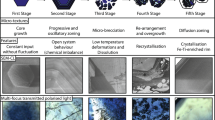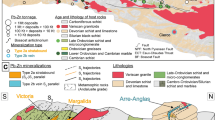Abstract
Shandong Province is the main producer of sapphire in China. Among the sapphire deposits discovered in China, Shandong sapphire hosted in Cenzoic basalt shows a great variety of features, especially for in zoning. These sapphire crystals are generally large in size, with depth in color and well-developed zoning. In this article, the characteristics of zonal sapphire have been studied by using petrography, trace element data from laser ablation inductively coupled with plasma-mass spectrometry, and Raman spectrometry. The trace elements variation is proposed to correspond with their parent magma composition, and the changes in growth environment of sapphire have resulted in the formation of zoning features. Sapphires from different geological settings have different characteristics. Trace elements in sapphire not only affect the color but also reflect the changes of physical and chemical conditions of sapphire growth. The concentration of impurity elements in the zoning core of Shandong sapphire is the highest, indicating that the parent magma of Shandong sapphire-host basaltic rock is rich in trace elements. Fe content is more than 2.00% in the zoning core, which causes the deepest color in the samples. It also suggests that the total content of Fe is positively correlated to the band color. The Raman spectrum shows that the spectrum peaks at 246 cm−1 caused by Fe3+ vary regularly with the band color, which shows that Fe is dominated by Fe3+ in Shandong sapphire. With the changes of forming condition, the parent magma composition has changed accordingly, which causes the zoning formation.





Similar content being viewed by others
References
J.X. Sun, F. Li, Y.S. Dang, G. Cui, and X.B. Zhou, Acta Petrol. Mineral. 24, 62 (2005).
L.S. Wang, Mineralogical Study the Causes of Chinese Gem Corundum Deposit Types, Distribution Cum Fuping Group Metamorphic Corundum Gemstone Deposits (Beijing: China University of Geosciences, 1996), p. 20.
W.K. Guo, L.S. Liu, and Z.J. Yu, Mineral Depos. 5, 1 (1982).
X.Y. Yu, X.M. Yao, and P. Han, Geol. Prospect. 36, 28 (2000).
Z.X. Dong, L.F. Yang, and Y.W. Wang, Bull. Chin. Acad. Geol. Sci. 20, 177 (1999).
G.W. Bowersox, E.E. Foord, and B.M. Laurs, Gems Gemol. Summer 36, 110 (2000).
A.R. Moon and M.R. Phillips, Sci. Alumin. 77, 356 (1994).
V. Pisutha-Arnond, T. Häger, W. Atichat, and P. Wathanakul, J. Gem. 30, 131 (2006).
F.L. Sutherland and D. Schwarz, Austral. Gemmol. 21, 30 (2001).
V. Garnier, D. Ohnenstetter, G. Giuliani, A.E. Fallick, T.P. Trong, V.H. Quang, L.P. Van, and D. Schwarz, Mineral. Mag. 69, 21 (2005).
Z.L. Dong, X.M. Chen, W.X. Hu, R.C. Wang, and M. Zhao, Acta Petrol. Sinica 23, 805 (2007).
Y.C. Song, W.X. Hu, and W.L. Zhang, Acta Petrol. Mineral. 27, 489 (2008).
M.I. Garland (Ph.D. dissertation, University of Toronto, Ontario, Canada, 2002), p. 137.
A. Abduriyim and H. Kitawaki, J. Gemm. 30, 23 (2006).
A.H. Rankin, J. Greenwood, and D. Hargreaves, J. Gemm. 28, 473 (2003).
H.P. Longerich, S.E. Jackson, and D. Günther, J. Anal. Atom. Spectrom. 9, 899 (1996).
S. Saminipanya, D.A.C. Manning, and G.T.R. Droop, J. Gemm. 28, 399 (2003).
E.B. Wilson, Jr., J.C. Decius, AND P.C. Cross, The theory of the Molecular Vibration, Infrared and Raman spectrum, 1st ed. (New York: Dover publications, 1980), p. 185.
V.C. Farmer, Infrared Spectrum of Minerals (London: Mineralogical Society, 1982), p. 235.
G.Z. Wu, Molecular Vibrational Spectroscopy: Theory and Principle (Beijing: Tsinghua University Press, 2001), p. 89.
J.L. Fan, S.G. Guo, J. Mao, and L.Y. Shi, Appl. Laser 27, 209 (2007).
Z.H. Ding, Acta Mineral. Sinica 29, 442 (2009).
Y.C. Song and W.X. Hu, Acta Petrol. Mineral. 28, 349 (2009).
P.X. Wu, J.P. Wu, W.D. Xiao, and C.W. Li, Geol. Geochem. 4, 40 (1997).
F.Y. Wu and Q. Lin, Acta Petrol. Mineral. 12, 126 (1993).
J.Z. Niu, Y. Liu, and Y.J. Di, Acta Petrol. Mineral. 33, 102 (2014).
M.Y. Hu, H.H. Liao, X.C. Zhan, X.T. Fan, G. Wang, and Z.R. Jia, Chin. J. Anal. Chem. 7, 950 (2008).
Acknowledgements
The authors acknowledge contributions in terms of helpful discussion and Raman experiment, with grateful thanks to Fei Liu of Chinese Academy of Geology Science and Hongyun Yu of Research Center of Material Science, Tsinghua University.
Author information
Authors and Affiliations
Corresponding author
Rights and permissions
About this article
Cite this article
Yu, X., Niu, X. & Zhao, L. Characterization and Origin of Zonal Sapphire from Shandong Province, China. JOM 67, 391–397 (2015). https://doi.org/10.1007/s11837-014-1270-y
Received:
Accepted:
Published:
Issue Date:
DOI: https://doi.org/10.1007/s11837-014-1270-y




